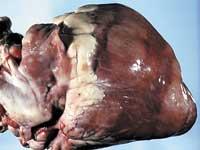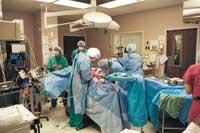Thank you from the heart
The operation was carried out at the Groote Sehur hospital. The receptor was called Louis Washkansky, was 54 years old and was terminal due to a serious heart disease. Dennise Aan Darvall, 23. The girl was hit by a car and when she arrived at the hospital nothing could be done for him. His father, desperate, gave permission to transplant his daughter's heart.

The donor and recipient were installed in the adjacent operating rooms. When the donor's heart activity stopped, they waited seven minutes to see that he was not breathing and that he had no reflexes. Then he was given as dead and his heart replaced that of man. The operation went very well: the heart immediately began to beat in the man's chest and, on the tenth day after the transplant, Louis Washkansky walked through the hospital room.
People followed Washkansky's situation day by day. The news spread by the media aroused the hope of those who suffered a serious heart disease; it seemed that heart transplants would become normal. But on the 18th day after the operation, Washkansky died. The drugs he took to prevent rejection completely disabled the man's immune system, which led to the capture of pneumonia and its death. Therefore, success was not total.
Barnard then continued to perform heart transplants, and although one of his patients managed to live more than a year after surgery, the rest did not last long. As in the case of Washkansky, drugs to prevent rejection left patients in a situation of unprotection and ran the risk of catching any infection. By 1971, of the 170 patients to whom the heart was transplanted, 146 were dead. Faced with this situation, the doctors decided not to perform any more heart transplants, including Barnard.
Cyclosporine revolutionized
Only Norman Shumway went ahead, with the first heart transplant in the US. Shumway created a group to analyze the problem of rejection. It was evident the need to “sleep” the immune system of the receptor so that the body accepted the foreign organ, and for this purpose immunosuppressants were used. However, this left the door open for infections.
In order to find a solution, the Shumway team invented a rejection prevention method that consisted of taking cardiac samples through a catheter, its analysis and the prediction of the rejection crisis. In this way, immunosuppressants only increased when there was a risk of rejection, while when there was no danger smaller doses were used and patients were more protected from infections.

But the biggest breakthrough came from cyclosporine. In 1974, a Norwegian researcher discovered in a fungus a substance called cyclosporine. Cyclosporine was found to be suitable for use in transplants, avoiding rejection of the foreign organ, but at the same time the recipient's immune system maintained the ability to respond to infections. Shumway tested it immediately and got good results.
After Shumway, many other doctors retook heart transplants and thanks to cyclosporine the life of the recipients lengthened. Later, other immunosuppressants have been found that are used in all transplants. Currently the main problem is not to treat rejection, but there are fewer transplant organs than necessary.
And before Barnard, what?
First references to transplants Although they are from the year 700 (a Hindu document of the time explains how to make grafts), XIX. Not much progress was made until the 20th century. At this time there were two great discoveries: anesthesia and antisepsis. From then on it was possible to perform and heal long and complex operations.

However, real advances XX. They came in the 19th century. At the beginning of the century Karl Landstein observed that there were four blood groups. Knowing this, safer transfusions could be made and the foundations of immunity were known. At the same time, Alexis Carrel developed a method of bonding between blood vessels. Along with Lindberg, he performed the first ‘artificial’ heart and, between 1902 and 1912, Carrel performed the first experimental heart and kidney transplants.
In the 1940s, Medawar explained why transplanted organs were rejected, and in 1955 Demijov succeeded in surviving the patient for 6 days, inserting the donor's heart without removing the recipient's heart. In 1957, Neptune, transplanting the heart and lungs together, made the patient live 6 hours and Webb and Howard, 22 hours. In 1964, Hardy injected the heart of a chimpanzee into a man and, although he died an hour later, it was seen that they technically dominated the operation. From that path Barnard got the first heart transplant in humans.





